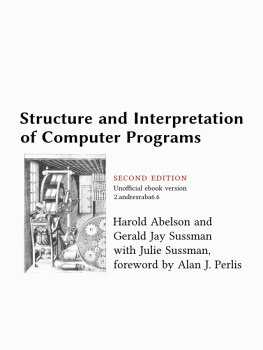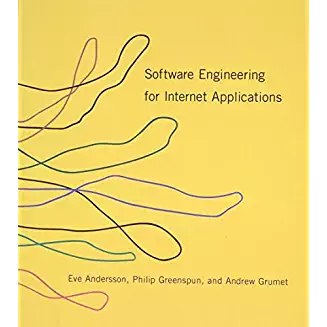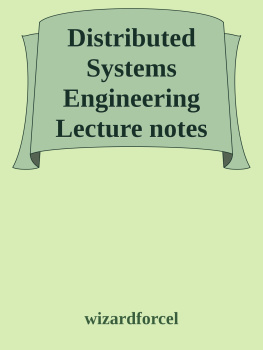it-ebooks - GeeksForGeeks Compiler Design Lecture Notes
Here you can read online it-ebooks - GeeksForGeeks Compiler Design Lecture Notes full text of the book (entire story) in english for free. Download pdf and epub, get meaning, cover and reviews about this ebook. year: 2018, publisher: iBooker it-ebooks, genre: Home and family. Description of the work, (preface) as well as reviews are available. Best literature library LitArk.com created for fans of good reading and offers a wide selection of genres:
Romance novel
Science fiction
Adventure
Detective
Science
History
Home and family
Prose
Art
Politics
Computer
Non-fiction
Religion
Business
Children
Humor
Choose a favorite category and find really read worthwhile books. Enjoy immersion in the world of imagination, feel the emotions of the characters or learn something new for yourself, make an fascinating discovery.

- Book:GeeksForGeeks Compiler Design Lecture Notes
- Author:
- Publisher:iBooker it-ebooks
- Genre:
- Year:2018
- Rating:4 / 5
- Favourites:Add to favourites
- Your mark:
- 80
- 1
- 2
- 3
- 4
- 5
GeeksForGeeks Compiler Design Lecture Notes: summary, description and annotation
We offer to read an annotation, description, summary or preface (depends on what the author of the book "GeeksForGeeks Compiler Design Lecture Notes" wrote himself). If you haven't found the necessary information about the book — write in the comments, we will try to find it.
GeeksForGeeks Compiler Design Lecture Notes — read online for free the complete book (whole text) full work
Below is the text of the book, divided by pages. System saving the place of the last page read, allows you to conveniently read the book "GeeksForGeeks Compiler Design Lecture Notes" online for free, without having to search again every time where you left off. Put a bookmark, and you can go to the page where you finished reading at any time.
Font size:
Interval:
Bookmark:
From: https://www.geeksforgeeks.org/compiler-design-tutorials/
Compiler is a software which converts a program written in high level language (Source Language) to low level language (Object/Target/Machine Language).
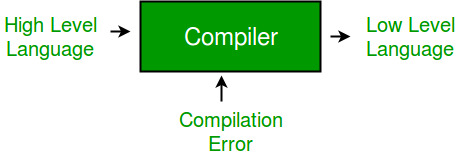
- Cross Compiler that runs on a machine A and produces a code for another machine B. It is capable of creating code for a platform other than the one on which the compiler is running.
- Source-to-source Compiler or transcompiler or transpiler is a compiler that translates source code written in one programming language into source code of another programming language.
Language processing systems (using Compiler)
We know a computer is a logical assembly of Software and Hardware. The hardware knows a language, that is hard for us to grasp, consequently we tend to write programs in high-level language, that is much less complicated for us to comprehend and maintain in thoughts. Now these programs go through a series of transformation so that they can readily be used machines. This is where language procedure systems come handy.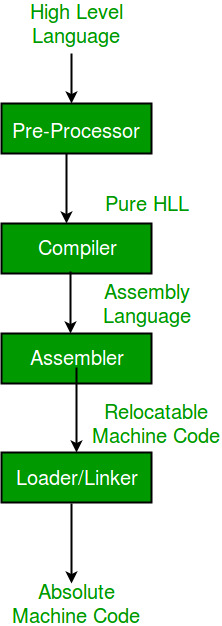
- High Level Language If a program contains #define or #include directives such as #include or #define it is called HLL. They are closer to humans but far from machines. These (#) tags are called pre-processor directives. They direct the pre-processor about what to do.
- Pre-Processor The pre-processor removes all the #include directives by including the files called file inclusion and all the #define directives using macro expansion. It performs file inclusion, augmentation, macro-processing etc.
- Assembly Language Its neither in binary form nor high level. It is an intermediate state that is combination of machine instructions and some other useful data needed for execution.
- Assembler For every platform (Hardware + OS) we will have a assembler. They are not universal since for each platform we have one. The output of assembler is called object file. Its translates assembly language to machine code.
- Interpreter An interpreter converts high level language into low level machine language, just like a compiler. But they are different in the way the read the input. The Compiler in on go reads the inputs, does the processing and executes the source code whereas the assembler does the same line by line. Interpreted programs are usually slower with respect to compiled ones.
- Relocatable Machine Code It can be loaded at any point and can be run. The address within the program will be in such a way that it will cooperate for the program movement.
- Loader/Linker It converts the relocatable code into absolute code and tries to run the program resulting in a running program or an error message (or sometimes both can happen). Linker loads variety of object files into a single file to make it executable. Then loader loads it in memory and executes it.
Phases of a Compiler
There are two major phases of compilation, which in turn have many parts. Each of them are take input from the output of the previous level and work in a coordinated way.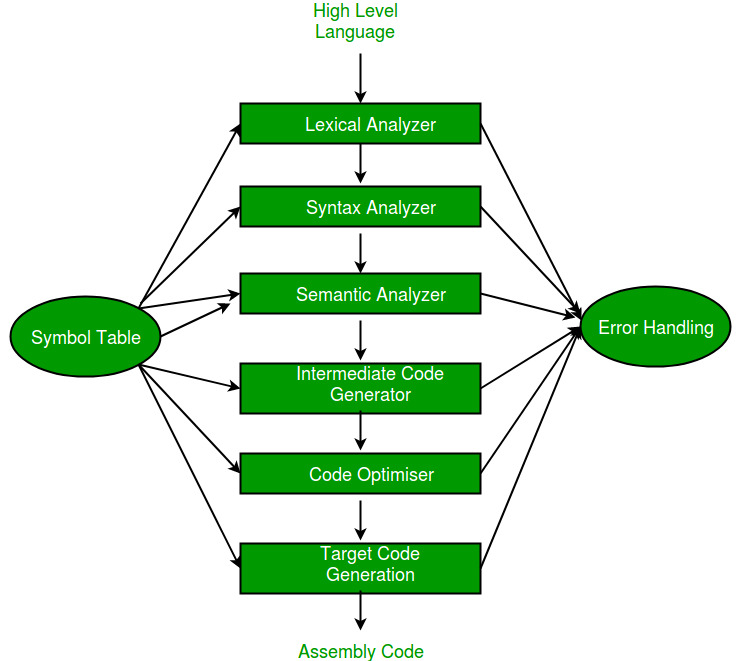
Analysis Phase An intermediate representation is created from the give source code :
- Lexical Analyzer
- Syntax Analyzer
- Semantic Analyzer
Lexical analyzer divides the program into tokens, Syntax analyzer recognizes sentences in the program using syntax of language and Semantic analyzer checks static semantics of each construct.
Synthesis Phase Equivalent target program is created from the intermediate representation. It has three parts :
- Intermediate Code Generator
- Code Optimizer
- Code Generator
Intermediate Code Generator generates abstract code, Code Optimizer optimizes the abstract code, and final Code Generator translates abstract intermediate code into specific machine instructions.
GATE CS Corner Questions
Practicing the following questions will help you test your knowledge. All questions have been asked in GATE in previous years or in GATE Mock Tests. It is highly recommended that you practice them.
- GATE CS 2011, Question 1
- GATE CS 2011, Question 19
- GATE CS 2009, Question 17
- GATE CS 1998, Question 27
- GATE CS 2008, Question 85
- GATE CS 1997, Question 8
- GATE CS 2014 (Set 3), Question 65
- GATE CS 2015 (Set 2), Question 29
References
Introduction to compiling viden.io
slideshare

If you like GeeksforGeeks and would like to contribute, you can also write an article using contribute.geeksforgeeks.org or mail your article to contribute@geeksforgeeks.org. See your article appearing on the GeeksforGeeks main page and help other Geeks.
Please write comments if you find anything incorrect, or you want to share more information about the topic discussed above.
Prerequisite Introduction of Compiler design
We basically have two phases of compilers, namely Analysis phase and Synthesis phase. Analysis phase creates an intermediate representation from the given source code. Synthesis phase creates an equivalent target program from the intermediate representation.

Symbol Table It is a data structure being used and maintained by the compiler, consists all the identifiers name along with their types. It helps the compiler to function smoothly by finding the identifiers quickly.
The compiler has two modules namely front end and back end. Front-end constitutes of the Lexical analyzer, semantic analyzer, syntax analyzer and intermediate code generator. And the rest are assembled to form the back end.
- Lexical Analyzer It reads the program and converts it into tokens. It converts a stream of lexemes into a stream of tokens. Tokens are defined by regular expressions which are understood by the lexical analyzer. It also removes white-spaces and comments.
- Syntax Analyzer It is sometimes called as parser. It constructs the parse tree. It takes all the tokens one by one and uses Context Free Grammar to construct the parse tree.
Why Grammar ?
The rules of programming can be entirely represented in some few productions. Using these productions we can represent what the program actually is. The input has to be checked whether it is in the desired format or not.Syntax error can be detected at this level if the input is not in accordance with the grammar.
Font size:
Interval:
Bookmark:
Similar books «GeeksForGeeks Compiler Design Lecture Notes»
Look at similar books to GeeksForGeeks Compiler Design Lecture Notes. We have selected literature similar in name and meaning in the hope of providing readers with more options to find new, interesting, not yet read works.
Discussion, reviews of the book GeeksForGeeks Compiler Design Lecture Notes and just readers' own opinions. Leave your comments, write what you think about the work, its meaning or the main characters. Specify what exactly you liked and what you didn't like, and why you think so.


